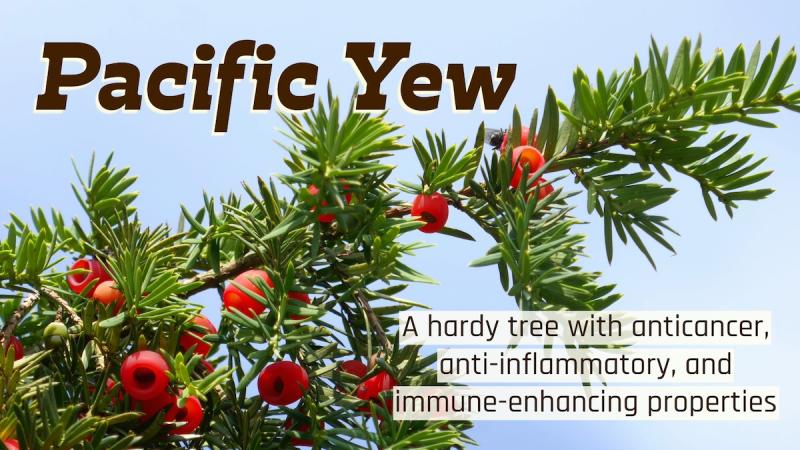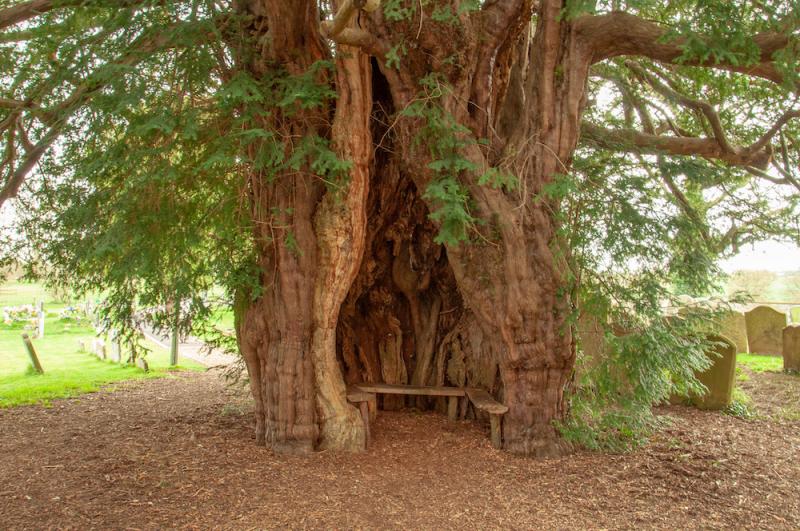
Last summer I was introduced to a new herb at the American Naturopathic Medical Association (ANMA) conference in Las Vegas. It’s the Pacific yew (Taxus brevifolia). Research funded by the National Cancer Institute discovered a compound in this plant called paclitaxel, a compound that can help inhibit cancer cell replication.
Paclitaxel is marketed under the trade name, Taxol, a popular chemotherapy agent. The paclitaxel for the drug was originally manufactured from the bark of the Pacific yew but is now being synthesized.
During this time, the founder of Bighorn Botanicals, the company that had been harvesting the bark, had been researching the traditional use of Pacific yew by Native Americans and had begun experimenting with the using the twigs. In addition to being able sustainably harvest the twigs, they concluded that the twigs were not only safe but had valuable medicinal use and began selling products made from them.
Yew Tree Folklore
 Before diving into what has been discovered about the plant, let’s talk about some of the folklore surrounding yew trees. Yew trees are hardy, long-lived trees that can live for hundreds, perhaps even thousands of years. As the tree ages, they are able to create new growth out of old branches. They recycle nutrients from the dying part of the tree to feed the new, young growth. This has caused them to be associated with longevity, death and rebirth, and even immortality. Yew trees can grow outward from the center and keep living.
Before diving into what has been discovered about the plant, let’s talk about some of the folklore surrounding yew trees. Yew trees are hardy, long-lived trees that can live for hundreds, perhaps even thousands of years. As the tree ages, they are able to create new growth out of old branches. They recycle nutrients from the dying part of the tree to feed the new, young growth. This has caused them to be associated with longevity, death and rebirth, and even immortality. Yew trees can grow outward from the center and keep living.
The yew tree is also seen as a symbol of protection. It was often planted near churches or graveyards in medieval times. Even though the trees can grow very tall (and have very large trunks) they can also be pruned to create dense, protective hedges. Other species of yew have been used as medicine, specifically Taxus baccata, but they are also poisonous and are no longer used in herbal medicine.
Yew Trees and Cancer
 Yew trees produce compounds called taxanes, which include paclitaxel marketed as the drug Taxol. However, there are many other taxanes found in Pacific yew. Taxanes prevent cancer cells from replicating. Cancer cells grow spindle fibers when they’re preparing to replicate. The new cancer cell grows at the end of the spindle fiber. Taxanes prevent these spindle fibers from disintegrating to form the new cancer cell. This allows the immune system to destroy the cells.
Yew trees produce compounds called taxanes, which include paclitaxel marketed as the drug Taxol. However, there are many other taxanes found in Pacific yew. Taxanes prevent cancer cells from replicating. Cancer cells grow spindle fibers when they’re preparing to replicate. The new cancer cell grows at the end of the spindle fiber. Taxanes prevent these spindle fibers from disintegrating to form the new cancer cell. This allows the immune system to destroy the cells.
When Bighorn Botanicals started harvesting the twigs in the 90s, they contacted the famous alternative cancer center, Bio-Medical Center in Tijuana, Mexico and started supplying them with the herb. The cancer clinic had positive results with a decoction made from the tips and continues to use it.
Other Uses for Pacific Yew
Pacific yew was utilized as a medicine by native American tribes. Besides containing over 100 taxanes (the anticancer compounds), it contains flavonoids, including quercitin, phytosterols, lignans, and carotenoids. These compounds give the herb anti-inflammatory, antiviral, antifungal, antibacterial, antioxidant and immune-stimulating properties. Some of the other reported uses for Pacific yew include arthritis, mercury toxicity, fighting infections, BPH and elevated PSA counts, and irritated skin.
Using Pacific Yew
 Most species of yew trees are extremely toxic. This is due to the presence of compounds that affect cardiac function called taxines. These are not to be confused with the taxanes. These are present in the English yew (T. baccata) and the Japanese yew (T. cuspidate) in concentrations from 0.5 to 1%. In contrast, Pacific yew contains only 0.0007% of these compounds, which means it is nontoxic. However, it is suggested that Pacific yew be avoided during pregnancy because of its traditional use as an emmenagogue.
Most species of yew trees are extremely toxic. This is due to the presence of compounds that affect cardiac function called taxines. These are not to be confused with the taxanes. These are present in the English yew (T. baccata) and the Japanese yew (T. cuspidate) in concentrations from 0.5 to 1%. In contrast, Pacific yew contains only 0.0007% of these compounds, which means it is nontoxic. However, it is suggested that Pacific yew be avoided during pregnancy because of its traditional use as an emmenagogue.
Pacific yew is currently available as a bulk herb for tea, capsules, tincture, oil extract, and salve. The tea is made as a decoction using 3 Tablespoons per quart of water. Drink one to two cups a day. You can also take two to six 300 mg. capsules daily. If you use the tincture (1:1.7) the dose is one dropper in 1 ounce of hot water, one to three times daily. You can also take two droppers of the oil up to three times daily. The salve can be applied topically to insect bites, burns, and other injuries.
I’m currently experimenting with Pacific yew and getting more practical, clinical experience. But, even though I just recently learned about this remedy, I think it is worth sharing and raising awareness about it.
Steven's Articles
-

-
The Evidence for Berberine
A yellow alkaloid found in traditional infection-fighting…
-

-
The Sensible Use of Caffeinated Herbs
Kola nuts, guarana, and yerba mate and other herbs…
-

-
The Health Benefits and Problems with Coffee
This popular caffeinated beverage can be beneficial…
October
-

-
Understanding Caffeine & Cellular Adaptation
Preserving the power of caffeine's buzz and the…
September
-

-
Horseradish
A pungent spice for aiding protein metabolism…
-

-
Banaba or Crepe Myrtle
A beautiful tree from Southeast Asia whose leaves…
August
-

-
Monkeyflowers
Flower essences to help see ourselves more clearly…
-

-
Mariposa Lilies
Strengthening the bond between mother and child…
-

-
The Noble Bay Leaf
A common kitchen herb for aiding digestion and…
-

-
Epimedium: Horny Goat Weed
A circulatory stimulant and kidney yang tonic…
July
-

-
The Medicinal and Nutritional Benefits of Apricots
A nutritious fruit and valuable medicinal seed for coughs
-

-
Dogwoods
Asian dogwood is used to stop excessive discharge,…
June
-

-
Neem: The Village Pharmacy
A popular Ayurvedic remedy for dental and immune…
-

-
Spilanthes: The Toothache Plant
A traditional remedy for teeth and gums, as well…
-

-
Forsythia
An anti-inflammatory, fever-reducing, and infection fighting herb

